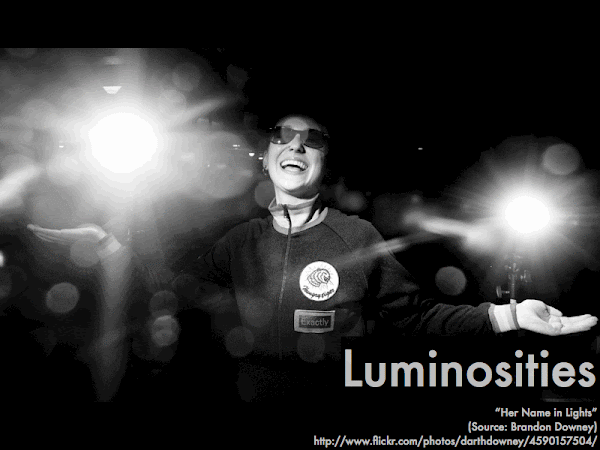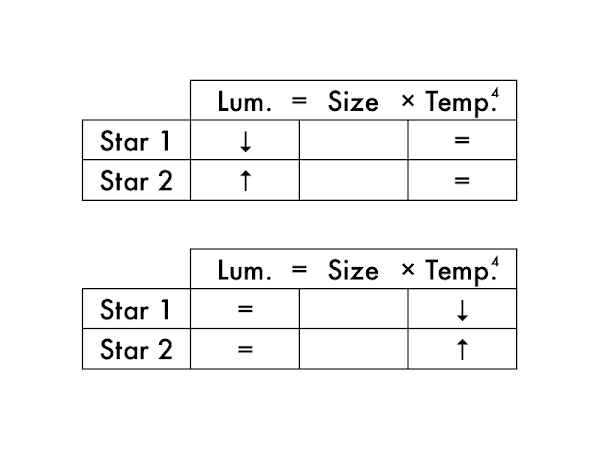Cuesta College, San Luis Obispo, CA
Students have a weekly online reading assignment (hosted by SurveyMonkey.com), where they answer questions based on reading their textbook, material covered in previous lectures, opinion questions, and/or asking (anonymous) questions or making (anonymous) comments. Full credit is given for completing the online reading assignment before next week's lecture, regardless if whether their answers are correct/incorrect. Selected results/questions/comments are addressed by the instructor at the start of the following lecture.
The following questions were asked on reading textbook chapters and previewing presentations on parallax, distance, apparent magnitude, absolute magnitude, Wien's law and the Stefan-Boltzmann law, and a TED-Ed talk on stellar properties.

Selected/edited responses are given below.
Describe something you found interesting from the assigned textbook reading or presentation preview, and explain why this was personally interesting for you.
"I liked the TED-Ed talk video because the visuals really helped solidify concepts from the video."
"The multiple ways that spectra can help determine the different characteristics of stars!"
"Using parallax to measure star distance was something I hadn't considered and thought that was a pretty cool concept."
"Parallax, because when I tried looking at a close object with one eye closed and then back and forth the object that was farther away did seem to move less than the closer object."
"How astronomers measure the distance of a star. I sometimes wondered how they did that, but now I see that its a process to do that. They take pictures from two points around Earth's orbit. They take one photograph and another six months later."
"That we can tell how far away something was by figuring out how far an object moved when viewed from two viewpoints, and then applied that knowledge on a larger scale using Earth's revolution around the sun! I really loved reading about how we learned how to figure that out in our book. Also, Gaia using these methods to provide the first 3D map of our galaxy hardly needs explaining why that's freaking amazing."
"One of my favorite songs is called 'Parsec.' Now the lyrics make way more sense!"
"That the brightness you see from Earth isn't actually a star's real brightness, like you could see a star that looks bright and one that looks dim but the dim one is actually brighter."
"That the sun 'cheats' in its brightness. I had never considered distance as a factor when comparing the brightness of the sun to other stars."
"The scale in which star brightness is measured--it is similar to the way that cross country running is scored. The team with the least points wins."
"That a negative magnitude represents the brightest stars."
"How there's a color code for determining a star's temperature because they are light years away."
"The color of a star is linked to its surface temperature. The hotter the star, the shorter the wavelength of light it will emit. The hottest ones are blue or blue-white, which are shorter wavelengths of light. Cooler ones are red or red-brown, which are longer wavelengths."
"Even though an object is blue it may actually be way hotter than an object that is red."
"How cooler colors (bluer colors) are from hotter stars. This is interesting because when I was a film major, blue lights also have a higher color temperature despite being used for cool atmosphere."
"I really enjoyed looking over what other students found either helpful or unhelpful when studying for tests and midterms. I was able to compare my studying habits with theirs and see in what areas I could improve."
"Everything. I liked the whole lesson."
Describe something you found confusing from the assigned textbook reading or presentation preview, and explain why this was personally confusing for you.
"Jow to rank the brightness of the star the apparent magnitude and absolute magnitude."
"In particular, I thought that the difference between absolute and apparent magnitude was confusing and I had trouble making the distinction."
"I could use some clarification on the apparent magnitude and magnitude scale."
"Parallax is kind of confusing to me. If we are to measure the distance of stars, how do we change our perspective from Earth?"
"Small parallax versus large parallax."
"If the sun is closer than some of the brighter stars, then in my head moving both objects to 10 parsecs away would still make the sun seem brighter than the other objects?"
"I do not understand parsecs at all."
"Star colors because they all look the same color from here at least to me."
"I found the Stefan-Boltzmann law to be confusing because even after reading through it twice, I'm still lost."
"The math behind star size and brightness. Maff is hard :("
"There's a lot to grasp in this section for me at this moment because I need more examples."
"Nothing so far."
"Everything was straightforward."
Explain how apparent magnitude and the absolute magnitude are defined differently.
"Apparent magnitude is the brightness of something in space as perceived from Earth. Absolute magnitude is the brightness of something in space as it actually is."
"Absolute magnitude compensates for distance, whereas apparent magnitude is the 'as is' view an observer on Earth has."
"Apparent magnitude measures the brightness of the star from Earth, not taking distance into account. Absolute magnitude equalizes all star at 10 parsecs so that distance doesn't affect the results."
Suppose the sun was moved to a distance of 10 parsecs away. As a result, its __________ magnitude would become dimmer.
absolute. ************** [14] apparent. *************** [15] (Both of the above choices.) ** [2] (Neither of the above choices.) * [1] (Unsure/guessing/lost/help!) *** [3]

(Only correct responses shown.)
1 (brightest): the sun, m = –27 [86%]
2: Canopus, m = –1 [77%]
3: Vega, m = 0 [83%]
4 (dimmest): Kapteyn's star, m = +9 [83%]
Rank the brightnesses of these stars (1 = brightest, 4 = dimmest; there are no ties), if relocated to 10 parsecs from Earth.
(Only correct responses shown.)
1 (brightest): Canopus, M = –3 [57%]
2: Vega, M = +0.5 [66%]
3: the sun, M = +5 [54%]
4 (dimmest): Kapteyn's star, M = +11 [66%]
Determine whether these stars get dimmer or brighter when relocated from their original positions to 10 parsecs from Earth.
(Only correct responses shown.)
The sun: gets dimmer [77%]
Canopus: gets brighter [69%]
Vega: gets dimmer [60%]
Kapteyn's star: gets dimmer [66%]
Rank the temperatures of these main sequence stars (1 = hottest, 4 = coolest; there are no ties).
(Only correct responses shown.)
Hottest: blue main sequence star [80%]
Second hottest: white main sequence star [83%]
Third hottest: yellow main sequence star [83%]
Coolest: red main sequence star [86%]
Rank the temperatures of these supergiant and dwarf stars (1 = hottest, 4 = coolest; there are no ties).
(Only correct responses shown.)
Hottest: blue supergiant [83%]
Second hottest: white dwarf [69%]
Third hottest: yellow supergiant [77%]
Coolest: red dwarf [89%]

dimmer. ***** [5] brighter. ************************** [26] (These stars would be the same size.) * [1] (Unsure/guessing/lost/help!) *** [3]
Two stars (equally far away) have the same brightness, but one star is cooler, and the other star is hotter. The __________ star will be larger in size.
cooler. **************** [16] hotter. ************* [13] (These stars would be the same size.) ** [2] (Unsure/guessing/lost/help!) **** [4]
Ask the instructor an anonymous question, or make a comment. Selected questions/comments may be discussed in class.
"Can you put a special lens on a telescope so that you can look directly at the sun?" (Actually, a metal-coated piece of glass. In fact, it only lets through only 0.00001% of the sun's light, such that you can see the sun safely, but everything else that you could possibly look at through it will be appear dark!)
"How can a star be way bigger than the sun?" (As we'll see when we survey all types of stars, our sun is actually a pretty average to low-average star in terms of brightness, temperature, and size. It is what it is.)
"Can you teach us tricks on how to remember all this information, please?" (I will.)
"Did you come up with this 'math but not math' method yourself? I love it! It's super-easy to understand." (Not my original idea, but I'm just adapting alternate approaches to doing math from a lot of different sources, even from my former students.)
"I'm confused about the dwarfs/supergiant's temperature and color. Is it the same for both?" (Yes, no matter what size the stars are, same color stars will have the same temperature.)
"A bigger star is hotter than a smaller star, regardless of color? Is this correct always?" (Not necessarily. For example, a red supergiant will be cooler than a white dwarf.)
"I found it interesting that hotter stars and cooler stars give off ultraviolet or infrared respectively that we can't see, but most stars give off light in the range we can see. It's so lucky that we are able to see such an adequate range, versus creatures like dogs. Sometimes, it feels like we were made to admire space." (Since our sun is an average warm star that gives off light with wavelengths between the ultraviolet and infrared, we've developed eyes that can see using this type of light. Otherwise we wouldn't be able to see anything in the daylight!)
"How is there room in your brain for all this?" (There is barely any room in my brain for all this stuff. That's why I need to teach it to you, so I can clear it out of my head.)
"I forget to do these assignments more than I could've hoped." (Then hopefully you won't forget to do the rest of these assignments.)
"I would love to know if I got the above answers right." (Part of the weekly online reading assignments is for you to read through the answers to these questions.)
"I'm actually pretty lost. I got the bits and pieces, but I just need help piecing them together."
"Can we go over this stuff in class and review what will be on the next quiz/exam please?" (Certainly. At least you've tried going over this stuff before coming to class, and have given me feedback on what you understand (or more importantly, don't understand) so I can best make use of time in class tonight.)
"Why are planets and stars so complex?!" (That's what makes them worth studying. Also that's what makes this class worth a transfer science credit.)
No comments:
Post a Comment